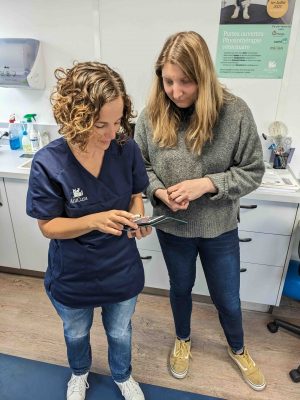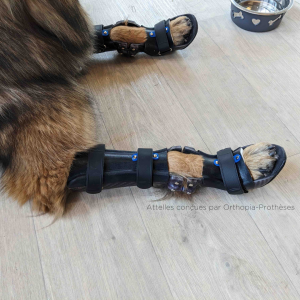Diagnosing locomotion pathologies early, alleviating pain, preventing injuries... There are numerous reasons for detecting lameness and asymmetries in dogs in veterinary medicine.
In this article, discover a new approach based on canine Tendiboots™ technology to facilitate the evaluation and monitoring of canine lameness.
Regular gait vs altered gait
In veterinary scientific research, locomotion analysis of animals can be conducted on both healthy animals and those affected by pathologies. Observations can be made on natural locomotion or asymmetries/lameness can be induced.
In the analysis presented below, locomotion modifications were induced for very brief periods (~10 seconds) and were non-invasive to the animal. The animal instantly returns to its initial gait, and any discomfort caused is temporary and lasts only a few seconds.
The methods applied allow for modification of the original locomotion (without lameness) up to intermittent lack of weight-bearing (grade 4 lameness) on the front limbs in a reversible manner and without injury to the animal.
No visible lameness (natural gait)
Obvious lameness with intermittent lack of weight bearing. Lameness graded 4/5 (impaired gait)
Lameness graded 1/5 (impaired gait)
Visual gradation of lameness
In canine practice, as in equine practice, veterinarians can rely on scales created to visually assess lameness.
The most common lameness grading system is divided into 5 main categories:
- Grade 0 : No lameness observed at walk and trot
- Grade 1 : Mild lameness observed, which may be intermittent and more noticeable at trot
- Grade 2 : Lameness is mild and consistent at walk and trot
- Grade 3 : Lameness is moderate and consistent at walk and trot
- Grade 4 : Lameness is severe and consistent, with some strides lacking ground contact
- Grade 5 : Lameness with no ground contact of the affected limb
Through this process, observations are subjective and dependent on the practitioner's experience for low-grade lameness.
Numerical data, on the other hand, allow for objectification and quantification of locomotion, even for asymmetries that are difficult to observe with the naked eye.
Ability of the Tendiboots™ canine system to detect lameness in dogs
The Tendiboots™ system has demonstrated its ability to detect the presence or absence of lameness during the tests presented earlier. It has also been able to highlight changes in weight distribution depending on the induced lameness.
Unaltered locomotion
No lameness observed

During these trials, the symmetry index indicated by the Tendiboots™ canine system was -1.3%.
The collected data revealed that the dog exhibited a relatively symmetrical distribution of maximum ground reaction forces between the front limbs in its natural gait.
This absence of lameness was also confirmed by the visual observation (on video) of two experienced veterinarians.
Altered locomotion
Grade 4 lameness observed

During these trials, notable alterations in locomotion were recorded. The symmetry index of the Tendiboots™ canine exceeded 10%, indicating significant deviations from normal gait patterns.
The data recorded by the system varied from one front limb to another, correlating with the limb affected by the induced lameness, and were consistent with the visual observations on video by two experienced veterinarians.
Altered locomotion
Grade 1 lameness observed

During these trials, the symmetry index had decreased to ~7.1%, indicating a less significant alteration compared to the previous test (grade 4 lameness).
The data recorded by the system also varied from one front limb to another, correlating with the limb affected by the induced lameness. The visual observations on video by the veterinarians were also correlated with the results.
The results of this research work have highlighted, under the conditions tested, the ability of the Tendiboots™ canine system to detect the effects of induced lameness on locomotion. It identifies the affected limb and provides an asymmetry index correlated with the lameness grades indicated by experienced veterinarians.
These results provide valuable insights into the potential of the analysis and artificial intelligence offered by the Tendiboots™ canine system for assisting in the detection and monitoring of lameness in dogs.
Conclusion
To conclude, the use of objective data for the analysis of canine locomotion offers several significant advantages:
- Diagnostic assistance: Objective data enables a precise and quantitative evaluation of the dog’s locomotion, thus aiding in establishing an earlier diagnosis of locomotor disorders
- Progress monitoring: By objectively recording locomotion parameters, it is possible to track the progression of lameness and asymmetries over time, which is crucial for assessing the effectiveness of treatments and interventions
- Decision support: Objective data provides tangible information for making informed decisions about the treatment and rehabilitation of locomotor disorders, which can lead to more effective outcomes for canine patients
- Communication: Objective data can be used to explain to pet owners the severity of their dog’s locomotor disorders and the importance of treatment and rehabilitation

In summary, the use of objective data for canine locomotion analysis contributes to improving the ability to diagnose, treat, and monitor locomotor disorders in dogs early, resulting in a better quality of life for the animals.




